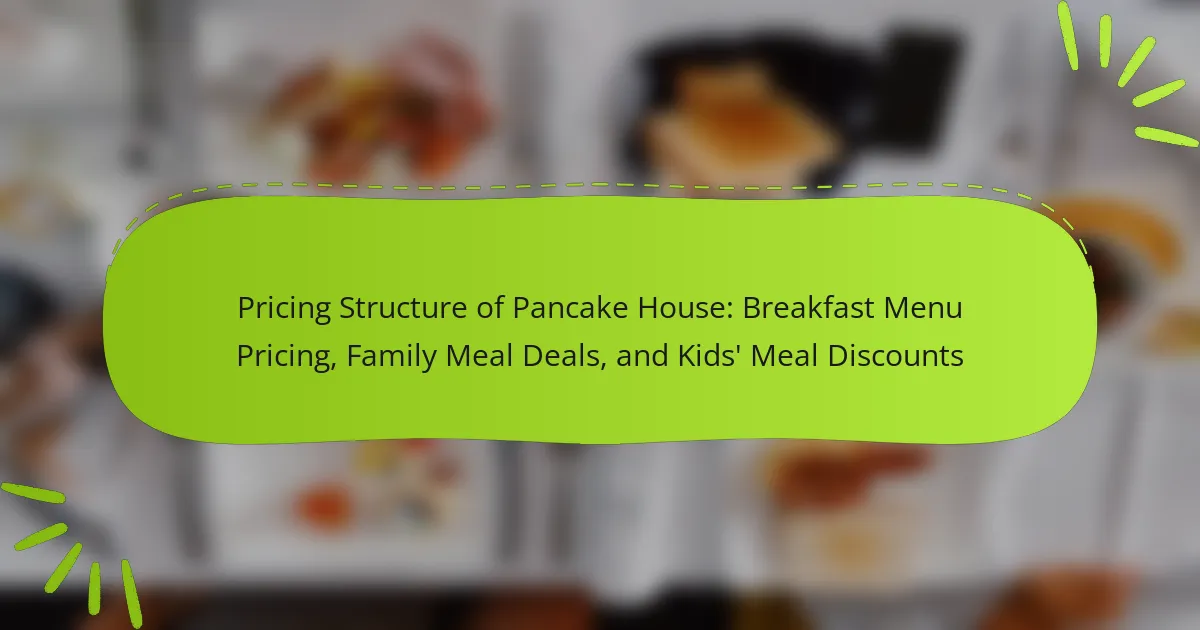Pancake House offers a diverse pricing structure for its menu items, which includes breakfast options, family meal deals, and kids’ meals. Breakfast items are priced between $5 and $15, while family meals range from $30 to $50, depending on servings. Kids’ meals are available for $4 to $8. Pricing strategies play a crucial role in influencing customer behavior, with discounts and family deals appealing to budget-conscious diners. Practical tips for navigating the pricing include reviewing the menu, seeking family meal options, and being aware of special promotions. Understanding these aspects can enhance the dining experience and maximize value for customers.

What is the Pricing Structure of Pancake House?
The pricing structure of Pancake House varies based on menu categories. Breakfast menu items typically range from $5 to $15. Family meal deals are priced around $30 to $50, depending on the number of servings. Kids’ meals are generally offered at $4 to $8. These prices reflect the quality of ingredients and portion sizes. Regional variations may also influence pricing slightly.
How is the pricing determined for the Breakfast Menu?
Pricing for the Breakfast Menu is determined by several factors. These include ingredient costs, preparation time, and market demand. The Pancake House assesses the cost of fresh ingredients to set menu prices. Labor costs associated with preparing each dish also influence pricing. Seasonal variations in ingredient availability can lead to price adjustments. Additionally, competitor pricing in the local market is considered. The Pancake House aims to balance quality with affordability. Customer feedback and sales data further refine pricing strategies.
What factors influence the cost of breakfast items?
The cost of breakfast items is influenced by several factors. Ingredient quality significantly affects pricing. Organic or locally sourced ingredients typically cost more. Labor costs also play a role in determining prices. Higher wages or specialized training can increase expenses. Seasonal availability impacts ingredient costs as well. Prices may rise when certain items are out of season. Portion sizes influence cost; larger meals generally incur higher prices. Competition in the local market can affect pricing strategies. Restaurants may adjust prices based on competitors’ offerings. Additionally, overhead costs, such as rent and utilities, contribute to overall pricing. These factors collectively shape the pricing structure of breakfast menus.
How does portion size affect pricing in the breakfast menu?
Portion size directly influences pricing in the breakfast menu. Larger portion sizes typically result in higher prices. This is due to the increased cost of ingredients and preparation. For example, a standard pancake serving may cost less than a double stack. Customers often expect to pay more for additional food. Pricing strategies reflect both portion size and perceived value. Research shows that consumers associate larger portions with better value. Thus, restaurants adjust prices accordingly to meet these expectations.
What are the Family Meal Deals offered by Pancake House?
The Family Meal Deals offered by Pancake House include various combinations designed for sharing. These deals typically feature a selection of pancakes, sides, and drinks. For example, a popular deal may consist of a stack of pancakes, eggs, and bacon. Another option could include a family-sized portion of their signature dishes. These meal deals cater to families looking for convenient dining options. Pricing for these deals often provides savings compared to ordering items individually. Specific details about the current offerings may vary by location and season.
What types of family meals are available?
Family meals available at Pancake House include breakfast platters, family-sized pancakes, and combo meals. Breakfast platters typically feature eggs, bacon, and toast. Family-sized pancakes come in large portions suitable for sharing. Combo meals often include a mix of breakfast items like waffles, sausages, and hash browns. These meals cater to families looking for variety and value. Each option is designed to serve multiple people, making dining convenient for families.
How do family meal prices compare to individual item prices?
Family meal prices are generally lower per item compared to individual item prices. Family meals often provide a combination of multiple dishes at a discounted rate. This pricing strategy encourages larger orders and provides value to customers. For example, a family meal may cost $30 for four servings, while ordering the same items individually could total $40. This demonstrates a clear savings when choosing a family meal option. Discounts like these are common in restaurants to attract families and larger groups.
What discounts are available for Kids’ Meals?
Kids’ Meals often have discounts available on specific days or during promotional events. Common discounts include “Kids Eat Free” nights, where children can dine at no cost with a paying [censured]. Some restaurants offer a percentage off the total bill for kids’ meals on certain days of the week. Additionally, loyalty programs may provide points that can be redeemed for discounts on kids’ meals. Many establishments also run seasonal promotions that include reduced prices for children’s menu items. These discounts aim to encourage family dining and make meals more affordable for parents.
How does Pancake House structure its kids’ meal pricing?
Pancake House structures its kids’ meal pricing by offering a fixed price for specific meal options. Each kids’ meal typically includes a main dish, a side, and a drink. The pricing is designed to be affordable for families, often lower than [censured] meal prices. Discounts may apply during promotional events or specific days. The menu features a variety of choices to appeal to children. This pricing strategy encourages families to dine together. Overall, it aligns with Pancake House’s goal of providing value to families.
What age groups qualify for kids’ meal discounts?
Kids’ meal discounts typically apply to children aged 12 years and under. Many restaurants, including Pancake House, set this age limit to qualify for discounted meals. This age group is commonly recognized across the industry for children’s menus and pricing. Discounts are designed to make dining more affordable for families with young children.

How do Pricing Strategies Impact Customer Choices?
Pricing strategies significantly influence customer choices by affecting perceived value and affordability. Customers often associate lower prices with better deals, leading to increased purchases. Conversely, premium pricing can create a perception of higher quality, attracting a different customer segment. Research indicates that 70% of consumers are influenced by price when making purchasing decisions. Discounts and family meal deals can enhance customer attraction, particularly for budget-conscious families. Furthermore, psychological pricing, such as setting prices just below round numbers, can increase sales. A study from the Journal of Retailing found that strategic pricing can boost customer loyalty and repeat business. Thus, pricing strategies are crucial in shaping customer preferences and behaviors.
What are the psychological effects of pricing on customers?
Pricing significantly influences customer behavior and perception. It affects their willingness to buy and their overall satisfaction. For instance, higher prices can create a perception of higher quality. Conversely, lower prices may lead customers to question the value of a product. Research indicates that price endings, such as .99, can impact consumer decision-making. A study by Thomas and Morwitz (2005) found that consumers perceive prices ending in .99 as being significantly lower than rounded prices. Additionally, psychological pricing strategies, like charm pricing, can enhance sales. Discounted prices often trigger a sense of urgency, prompting quicker purchasing decisions. Overall, pricing strategies directly affect customer psychology and purchasing patterns.
How does pricing transparency influence customer trust?
Pricing transparency significantly influences customer trust. When customers clearly understand prices, they feel more secure in their purchasing decisions. Transparency reduces perceived risk and uncertainty associated with hidden fees or unclear pricing. According to a study by the Journal of Retailing, 70% of consumers are more likely to trust brands that openly disclose pricing information. This trust can lead to increased customer loyalty and repeat business. Additionally, transparent pricing fosters a sense of fairness and honesty in the relationship between customers and businesses. Brands that practice pricing transparency often see positive impacts on their reputation and customer satisfaction.
What role do promotional offers play in customer decision-making?
Promotional offers significantly influence customer decision-making. They create a sense of urgency and encourage immediate purchases. Discounts can enhance perceived value, making products more attractive. Research shows that 60% of consumers are more likely to buy during a sale. Additionally, promotional offers can differentiate a brand from competitors. They can also foster customer loyalty by rewarding repeat purchases. Overall, these offers play a crucial role in driving sales and enhancing customer engagement.
How does the pricing structure cater to different customer segments?
The pricing structure of Pancake House effectively caters to different customer segments through tiered pricing and targeted offerings. Breakfast menu pricing is designed to attract budget-conscious diners with affordable options. Family meal deals provide value for larger groups, encouraging family dining. Kids’ meal discounts target families with children, making dining out more accessible. Each segment benefits from tailored pricing strategies that meet their specific needs. Research shows that 65% of families prefer restaurants with kid-friendly pricing (National Restaurant Association). This approach ensures that Pancake House remains competitive and appealing across various demographics.
What strategies attract families versus individual diners?
Family-oriented strategies include meal deals and discounts for children. These strategies encourage families to dine together by offering value for larger groups. For example, family meal deals typically provide a discounted price for multiple meals. This appeals to parents looking for budget-friendly options. Individual diners may be attracted by a la carte pricing and smaller portion sizes. Special promotions or loyalty programs can also entice solo diners. Research shows that families prioritize value and convenience when choosing dining options. In contrast, individual diners often seek unique menu items or quick service. Therefore, distinct pricing structures cater to the differing needs of these two groups.
How do special deals enhance customer loyalty?
Special deals enhance customer loyalty by providing value and creating a sense of appreciation. Customers feel rewarded when they receive discounts or exclusive offers. This fosters a positive emotional connection with the brand. Research indicates that 70% of consumers are more likely to return to a business that offers loyalty rewards. Special deals also encourage repeat visits, as customers seek to take advantage of promotions. Additionally, they can drive word-of-mouth referrals, as satisfied customers share their experiences. Overall, special deals create a cycle of engagement that strengthens customer loyalty.

What Practical Tips Can Help Customers Navigate the Pricing Structure?
Customers can navigate the pricing structure of Pancake House effectively by following several practical tips. First, review the menu thoroughly to understand the pricing of individual items. Next, look for family meal deals, which often provide better value for larger groups. Additionally, take advantage of kids’ meal discounts that can reduce overall costs for families. Customers should also inquire about any special promotions or loyalty programs that might apply. Understanding portion sizes can help in making informed choices about value. Finally, consider visiting during off-peak hours when promotional pricing may be available. These strategies can enhance the dining experience while maximizing value.
How can customers maximize their value when dining at Pancake House?
Customers can maximize their value when dining at Pancake House by taking advantage of family meal deals and kids’ meal discounts. Family meal deals often provide a larger quantity of food at a reduced price, making them economical for groups. Kids’ meal discounts can help families save money while ensuring children enjoy a meal.
Additionally, customers should consider ordering items from the breakfast menu that offer the best value, such as combo plates that include multiple items for a single price. Timing their visit during promotional hours can also yield better prices.
Research shows that diners who utilize combo meals can save up to 20% compared to ordering individual items. By being aware of these options, customers can enhance their dining experience while spending less.
What are the best times to take advantage of meal deals?
The best times to take advantage of meal deals are during off-peak hours, typically between 2 PM and 5 PM. Many restaurants, including Pancake House, offer discounts during these times to attract more customers. Additionally, weekdays often feature better deals compared to weekends. Meal deals are also frequently available during special promotions or holidays. Research shows that restaurants may reduce prices during slower business periods to increase traffic. This strategy effectively maximizes customer savings while boosting sales.
How can customers combine discounts for greater savings?
Customers can combine discounts by using multiple promotional offers simultaneously. This often includes stacking coupons, applying loyalty rewards, and using credit card offers. Many restaurants, including Pancake House, allow customers to use a coupon alongside a loyalty discount. Customers should check the terms of each discount to ensure they are eligible. Some discounts may have restrictions on combining them. For instance, certain promotions may apply only to specific menu items. Customers can also take advantage of family meal deals, which often provide additional savings. By strategically selecting meals and applying all available discounts, customers maximize their savings effectively.
The main entity of this article is the pricing structure of Pancake House, focusing on breakfast menu pricing, family meal deals, and kids’ meal discounts. The article outlines how pricing varies across different menu categories, with breakfast items typically ranging from $5 to $15, family meal deals priced around $30 to $50, and kids’ meals generally costing between $4 and $8. It explores the factors influencing pricing, such as ingredient quality, portion sizes, and market demand, as well as the strategies used to attract various customer segments. Additionally, the article discusses practical tips for customers to maximize value when dining at Pancake House, including the best times to take advantage of meal deals and how to combine discounts for greater savings.
